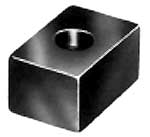
Precision is important when machining parts. If a part is misaligned or otherwise out of position, you may struggle to accurately machine it. While you can always use traditional step keys or slot fixtures, though, another idea is to use fixture keys. What are fixture keys, and how do they work exactly?
Overview of Fixture Keys
Fixture keys are components used to locate machinery fixtures. Fixtures, of course, are workholding and locating devices. They hold and locate parts while the parts are being machined.
Fixture keys are slotted parts that facilitate this process. They are designed for use on machine tables. You can mount a fixture key on a machine table, after which you can use it to hold and locate the part for a machinery process.
How Fixture Keys Work
Fixture keys work by providing a connection point for a part and the machine table on which they are mounted. You can find them in different styles. Standard fixture keys, for instance, feature a square or rectangular shape with a hole in the center. Step fixture keys, on the other hand, feature a similar design but with a protruding rim.
There are also sine fixture keys. Sine fixture keys consist of a dowel attached to a rectangular base. You can mount them by reaming holes.
Why Use Fixture Keys
Why should you use fixture keys exactly? As workholding and locating devices, they promote precise machining processes. You can perform machining processes more accurately and easily by using fixture keys.
Fixture keys are also cost-effective. They are typically made of stainless steel, such as 1018 or 1045 steel. Many of them are further treated with a coating of black oxide to protect against corrosion and premature wear and tear. Regardless, their small size and simple design means they are inexpensive.
Choosing Fixture Keys
There are several things you should consider when choosing fixture keys. One of the most important things is the style. As previously mentioned, fixture keys are available in different styles. Some of the most common styles include standard, step and sine.
You should consider the size when choosing fixture keys. There’s no one-size-fits-all fixture key; some fixture keys are larger than others.
You should also consider the screw size when choosing fixture keys. Reamed-hole fixture keys, such as sine, are fastened with a screw. You can typically fasten them from either above or below using a socket-cap screw of the appropriate size.
